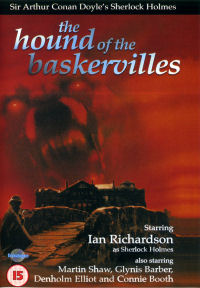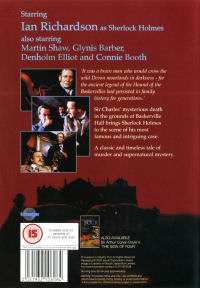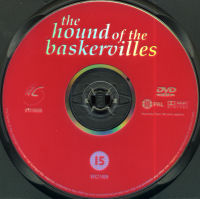
25.8.2014 #584
German Original 13.12.2009 #477
by Guido Bibra
![]() The Movie
The Movie
For Generations, the Baskervilles have been haunted by a curse - at least that is what Dr Mortimer thinks, a friend of the family, who have their estate in lonley Dartmoor. A local legend tells of a ghostly hellhound wandering the moors, who is said to have killed an ancient forbear of the Baskervilles. When Sir Charles, the last descendant of the Baskervilles, dies under mysterious circumstances and the footprints of a gigantic hound are found, the puzzled Dr Mortimer seeks the help of Sherlock Holmes. The doubts and fears around the legend of Baskerville have to be eliminated before the last living heir, Henry Baskerville, arrives from America. Although Holmes is too busy in London to work on the case himself, he sends off Dr. Watson to Dartmoor to keep an eye on Sir Henry...
At the beginning of the 1980s, the American-British producer team of Sy Weintraub and Otto Plaschkes had started to produce a series of Sherlock Holmes television movies, originally planning at least for a dozen episodes to be marketed both in England and the US. But the British private television channel ITV and the production company Granada thwarted those plans with their own announcement of a Holmes television series, provoking a legal fight about the copyright of Arthur Conan Doyles novels and short stories. Granada was able to win this dispute by settling out of court with Weintraub and Plaschkes, reportedly paying them a large enough sum to let them stop their production and still get a little profit. Two movies had, however, already been produced with Ian Richardson in the title role during the litigation process: The Sign of Four and The Hound of the Baskervilles, two of the only four long-form novels of the Holmes canon.
As one of the most-filmed Sherlock Holmes stories, The Hound of the Baskervilles is certainly no easy work for a filmmaker considering the many predecessors, but Sy Weintraub and Otto Plaschkes caved in to the temptation of making yet another version. After the successful adaptation of The Sign of Four, the expectations of this ambitious endeavour were extremely high, because this new incarnation of The Hound of the Baskervilles did not have it easy competing against its two most famous predecessors, the 1939 Basil Rathbone and Nigel Bruce movie and Hammer Studio's seminal 1959 production with Peter Cushing and Andre Morell.
The producers apparently had planned to give every episode of their series to a different director. While The Sign of Four had been the responsibility of Desmond Davis, Sy Weintraub and Otto Plaschkes had chosen the British director Douglas Hickox for The Hound of the Baskervilles. He had originally started as an assistant director in the 1950s and had worked on movies of all genres since the 1960s before coming to television for the first time with The Hound of the Baskervilles. His experiences from the big screen were very valuable for a thoroughly cinematic production and made sure that the movie was more than just a small-time television adaptation.
Although filmed by a different director this time, the script was again written by Charles Edward Pogue, who had before worked on The Sign of Four and now had the great challenge of adapting a story in which the main protagonist is absent for half the time. Pogue had solved this problem in a very original way, but regarding the horror elements he deviated very far from the original to make the story more palatable for the international television audience. Fortunately, the author did not go completely overboard and even managed to use a lot of the original dialogue, but there were a lot of major changes in the plot.
Like almost every other adaptation of the story, this one begins with the death of Sir Charles Baskerville, which is used in this version to give the viewer a powerful preview of the eponymous hound. The beginning of the plot in London is relatively true to the original and in contrast to the later Granada version the medieval pre-story has been actually filmed, if in a somewhat drastic, but very effective way. Here, Sir Henry is not only being observed, but even almost assasinated, giving the script the opportunity to show the hunt for the cab driver and demonstrate Sherlock Holmes methods. Like in most other versions of the story, the search for the sender of the threatening note is only hinted at to keep the plot moving forward.
With the beginning of the story in Dartmoor, the first big differences from the original are noticeable. With Geoffrey Lyons, a completely new character has been added who is only briefly mentioned in the novel and is mostly there to add another completely unrelated murder to the last third of the story, making the antagonist even more evil. Sherlock Holmes is never completely out of the picture, wandering the moors in the disguise of a gypsy and meeting almost all of the characters in a cat-and-mouse-game spanning the whole middle of the movie. This was a surprisingly elegant solution to give the actor something to do in the absence of his character and was even quite plausible in the scope of Conan Doyle's original story.
The early appearance of Inspektor Lestrade is also an invention of this particular script, which was not really necessary and only puts more strain onto a story which already suffers from an overabundance of characters. While the plot itself has largely been faithfully adapted and the relationships between the characters are mostly identical to the novel save for the Lyons, the finale has been significantly changed. Instead of Sir Henry, Sherlock Holmes himself has to fight with the hellhound and after the mutt has been disposed with the help of Watson's trusty army revolver, a gunfight with the antagonist follows, who quite true to the original is then swallowed up by the moor. It is a very self-satisfied finale full of good old American television action, but still a good representation of the story.
For Sherlock Holmes, the producers had already chosen the british actor Ian Richardson during the production of the first movie, who played the master detective a little less serious and moody than his later successor Jeremy Brett. The slightly mischiveous and sometimes humorous version of the character does not correspond very much to Arthur Conan Doyle's ideas about the character, but Ian Richardson is nevertheless not miscasted and also manages to show the more serious sides of the character. Holmes' passion for disguises is also used to great effect in this adaptation to give Ian Richardson something to do in the middle of the plot, creating some of the much-needed funnier moments of the movie.
The biggest problem of this adaptation of The Hound of the Baskervilles is, like in many other versions, Doctor Watson, who is not portrayed after Arthur Conan Doyle's original, but like first established in the American movies of the 1940s, played by Nigel Bruce as a doddering old fool. In this movie, the character change is not as drastic like in the Rathbone movies, but compared to the at least somewhat straightforward approach by David Healy in The Sign of Four, Donald Churchill is unfortunately a sad laughingstock here. His Doctor Watson is just meant as a humorous diversion and the original importance of the character, who is the real protagonist of the story, has been dialed down so much by Charles Edward Pogue that the actually very capable actor is forced to play a very dumb and silly version of the Doctor.
Unfortunately, the producers also did not take the opportunity to cast Sir Henry Baskerville with an American actor. Instead they hired Martin Shaw, who previously had become famous for being one of the three lead actors of the British television series The Professionals from 1977 to 1983. As Sir Henry, he is surprisingly flat and colourless, even though his character was written as a sun-bronzed American cowboy even with matching hat. His character just seems very artificial and unrealistic, almost like a weak parody not entirely unlike Doctor Watson himself. This is mostly because Shaw's dialogue was dubbed by another unknown actor with a terribly fake-sounding American accent, completely ruining the actor's delivery.
Also somewhat miscast was Glynis Barber as Beryl Stapleton. The English actress, who shortly after The Hounds of the Baskerville became famous as one half of the British television series Dempsey and Makepeace, does play her role very well, if a little too dramatic and theatrical. Unfortunately, as a blonde beauty she does not fit Arthur Conan Doyle's description of the character at all, who envisioned her as a dark-haired woman of Spanish origin, leaving out an important aspect of the story. In contrast, the producers had made an ideal choice with Nicholas Clay for Jack Stapleton, one of the most important characters of the story. The actor, who was both at home in cinema and television, portrayed Stapleton very close to the original novel as a mystery to figure out for the viewer.
In a very high-profile casting, but also not very true to the source, the producers had chosen the British actor Denholm Elliot for Doctor Mortimer, who apparently wanted to make amends for his appearance as Jack Stapleton in the terrible parody movie of The Hound of the Baskervilles with Peter Cook and Dudley Moore a few years previously. Here he has the chance to shine as the quite serious, but also a bit doddery Doctor Mortimer, bringing the character to life in a very memorable way, although not very close to the original novel, where Mortimer is described as a young and enthusiastic country doctor. Unfortunately, the script writer had no more use for the character after the first third of the movie and only let him reappear in the finale, although Denholm Elliot would have had plenty of opportunities to appear elsewhere in the movie.
Appearing very early in the plot on the first arrival in Dartmoor is the added character of Geoffrey Lyons, played by British actor Brian Blessed, who had made his mark with almost every of his larger-than-life, bombastic appearances in many movies and television series. In The Hounds of the Baskervilles, he is not a humorous character at all, but magnificently dangerous and very much living up to his name. Lyons' wife Laura, who is only tracked down by Sherlock Holmes at a very late point in the novel, has a bigger role in this version of the story and is played by Connie Booth. The British actress had originally begun her career as a comedian together with her now former husband John Cleese as an extra on Monty Python's Flying Circus and later Fawlty Towers, but had later successfully established herself as a serious actress playing roles like Laura Lyons very expertly.
Inspector Lestrade is also not only present in the finale, but is involved a few times over the course of the story, played here brilliantly by the great character actor Ronald Lacey, who had an even bigger appearance four years later in Granada's version of The Sign of Four. The unfortunately only very small roles of the Barrymores, Baskerville Hall's servant couple, were also perfectly cast with Eleanor Bron and Edward Judd, who would have deserved a bigger appearance than their drastically truncated characters.
Sy Weintraub and Otto Plaschkes had quite noticeably put a lot of money into The Hound of the Baskervilles, because the high production standards of The Sign of Four had been continued. All locations shooting was actually done in Dartmoor, showing the gloomy moor landscape at its best and ensuring a very moody and foreshadowing atmosphere. For the exterior of Baskerville Hall, Knightshayes Court in Devon was chosen as a fitting victorian country house, although it was actually not from the correct epoch considering how old the family Baskerville is supposed to be. It seems to be somewhat too comfortable and not imposing and creepy enough. The interiors seem to be sets built in the Shepperton Studios, where all studio work was done, looking much more like a 16th century manor.
The appearances of the eponymous hound are, of course, the centerpieces of the movie, even if they are limited to only a few short scenes. In the finale, the ghostly canine is represented by an actual dog without much use of special effects and the glowing phosphor trick from the original novel is only seen in a previous scene showing the hound in the distance, but both sequences are very effective and the beast looks very frightening and dangerous. The hound has also the honour of attacking Sherlock Holmes and not Sir Henry, providing the opportunity for a quick, but suspenseful fight. Overall, the night scenes in the moor, which seem to have been staged in the studio for better lighting control, have a wonderfully creepy and scary atmosphere and fully live up to the original novel.
The second and last Sherlock Holmes television movie with Ian Richardson in the title role had mastered the ambitious challenge of successfully adapting one of the most popular and also most difficult of Arthur Conan Doyle's works. Although this incarnation of The Hound of the Baskervilles still takes a lot of liberties and has a somewhat inconsistent casting, it is undoubtedly one of the best productions of the novel and does not need to hide from its predecessors thanks to the great atmosphere, solid camera work and excellent actors. At the same time, it was one of the more sensational and bloodthirsty versions of the story noticeably geared towards the American audience, something the Granada version did completely differently five years later. Ian Richardson's encounter with the Hound of the Baskervilles is, however, quite rightly often mentioned together with the 1939 and 1959 adaptations.
Together with The Sign of Four, The Hound of the Baskervilles had first been shown in late 1983 on the American pay television channel HBO, but was later sold to many other stations worldwide. In England, the movies were first shown on Channel 4 and even the German ZDF had secured the rights and had shown it in its dubbed version simultaneously with the English original several times. But since over a decade, this incarnation of The Hound of the Baskervilles has not been shown on German or British television again.
![]() The DVD
The DVD
The Hound of the Baskervilles with Ian Richardson had already been released on DVD in the USA in 1999 by Image Entertainemt, soon followed by the British release from another company reviewed in this article. Although it is basically a cheap release fit for the bargain bin, image and sound are surprisingly acceptable. There are, of course, no extras and only a very basic menu, but this disc provides the opportunity to watch the movie in its original version, unlike the 2009 German release which was put out only with a German soundtrack.


![]() Image
Image
According to the website of the license owner Zia Film this adaptation of The Hound of the Baskervilles had been "remastered" in 1999, so that there must have already been been a digital transfer available. The image quality is surprisingly good considering the circumstances and even a little better than on The Sign of Four, although the DVD is not able to hide its age.
The film source leaves the impression of being overall very clean with only some isolated dirt particles and no further dropouts or damages. Image stability is excellent and the depth of the 35mm source is definitively noticeable, but sharpness is slightly limited due to the older transfer technology. The image looks a little soft, but nevertheless has a lot of detail and was also not made worse with additional sharpening. Film grain is hardly visible and has apparently been removed with a heavy noise filter which has flattened down the image somewhat and seems also responsible for the not altogether perfect sharpness.
Colour reproduction is excellent considering the movie has a very moody colour palette which is almost monochrome and subdued, but also has some lighter elements. Brightness and contrast are well balanced and bring out many details completely lost in older transfers especially in the many dark scenes on the moor. The compression fits the movie comfortably on the single-layer disc and should have enough margin with a bitrate of about 5.5 mbit/s to avoid artifacts, but some are occasionally still visible. This DVD will not look pretty on larger screens due to its age, but it is still the best version of the movie available.
![]() Sound
Sound
The British DVD release of The Hound of the Baskervilles contains only the original english soundtrack in the original mono mix.
The soundtrack is not really able to hold up against cinema productions of its age, but still has a very solid quality which can't be faulted much. The voices are perfectly intelligible and sound very natural apart from Martin Shaw's unfortunately re-dubbed voice. Lip synchronity is much better than in The Sign of Four and the voices fit in perfectly into the mix. The music has a good frequence response sounding less like a little television movie than a big movie production with solid bass and trebles.
There are unfortunately no subtitles in any languages on this DVD.